Advanced hikers facing extreme weather must blend endurance and strength with strategic preparation. Start with aerobic conditioning through long hikes or cycling to build stamina, then incorporate dynamic movements and balance drills, like twisting lunges, for agility on unstable terrains. Simulated weather training helps the body adjust, while targeted strength exercises like squats and deadlifts prepare muscles. Nutrition and hydration play pivotal roles; practice fueling strategies in various conditions. Finally, prioritize injury prevention with core stability drills and stretching. Discover techniques to optimize gear selection and mental resilience to truly conquer the wildest elements.
Key Takeaways
- Practice simulated weather training to adapt to extreme conditions like high winds and low oxygen levels.
- Enhance cardiovascular fitness with HIIT and steady-state cardio for rigorous demands of hiking.
- Focus on balance and agility drills to improve stability and proprioception on rugged terrains.
- Develop muscular endurance and core stability through squats, lunges, and planks for challenging hikes.
- Test and refine hydration and nutrition strategies to ensure sustained energy and optimal performance.
Building Physical Resilience
Building physical resilience for extreme weather hiking is an essential undertaking that demands a thorough approach to fitness and conditioning. To face nature's harshest conditions, hikers must cultivate not only physical strength but also mental preparedness and acute environmental awareness.
Aerobic conditioning, through activities like long-duration hiking or cycling, is fundamental for developing the stamina required to endure prolonged exposure to challenging weather. This aerobic base serves as the foundation for tackling diverse terrains and unpredictable climates.
Dynamic movement and balance exercises, such as twisting lunges and banded side steps, enhance proprioception and control. These exercises are significant for maneuvering unstable environments, where precise movements can prevent injuries.
Equally important is a dedication to recovery techniques, including regular stretching and foam rolling, which help maintain flexibility and reduce muscle soreness, ensuring the body remains resilient for future excursions.
Gradually increasing the intensity and complexity of training regimens is paramount. By simulating the conditions one might encounter during extreme weather hikes, the body can adapt to the physical and psychological stressors of the trail.
This holistic approach, combining physical conditioning with mental readiness and environmental vigilance, equips hikers to thrive in the most demanding situations.
Strength Training Essentials

As hikers prepare for the rigors of extreme weather conditions, cultivating a robust strength training regimen becomes a significant component of their preparation strategy. This regimen focuses on gradually overloading the muscles and connective tissues to enhance their ability to absorb force, critical for both uphill and downhill trekking.
A structured program typically unfolds in three phases, beginning with foundational exercises like squats, lunges, and deadlifts. These movements lay the groundwork for tackling challenging terrains by reinforcing essential movement patterns.
The next phase emphasizes muscular endurance through high repetitions with low weights, a practice that spans 4-6 weeks. This approach not only improves stamina but also primes the body for the prolonged exertion demanded by extreme conditions.
To guarantee safety and effectiveness, gradual increments in both weight and distance are significant. This methodical progression helps avert overtraining and injury while promoting balanced muscle development.
Core stability and lower body strength, essential for maneuvering rugged trails, are further honed through resistance exercises such as planks and step-ups. These exercises fortify the body's balance and control, equipping hikers to face unpredictable paths with confidence and resilience.
Cardiovascular Conditioning
Cardiovascular conditioning is a cornerstone of preparing for extreme weather hiking, where both the heart and lungs must perform efficiently under pressure.
By engaging in high-intensity interval training (HIIT), hikers can effectively boost their cardiovascular fitness and adapt to the rigorous demands of unpredictable environments.
Complementing HIIT with long-distance endurance building and aerobic interval techniques guarantees a thorough approach, enhancing both physical endurance and mental resilience for the challenges ahead.
High-Intensity Interval Training
Integrating High-Intensity Interval Training (HIIT) into your hiking preparation can transform your cardiovascular conditioning, equipping you with the stamina and resilience needed for extreme weather hikes. The HIIT benefits are profound, offering a potent metabolic boost that fosters both fat loss and endurance gains.
By alternating between intense bursts and recovery periods, HIIT maximizes training intensity while minimizing time commitment. This makes it ideal for advanced hikers who need efficient workouts to improve their anaerobic capacity for challenging terrains.
Interval variations allow you to customize workouts, tailoring them to your fitness level and hiking goals. For instance, you can adjust the length and intensity of intervals to simulate the demands of steep ascents.
Recovery strategies are equally important, as they guarantee you can maintain high performance throughout your session. Performance tracking is another key element, helping you monitor progress and adjust your training regimen as needed.
Engaging in HIIT 2-3 times per week can greatly enhance your VO2 max, a vital factor for high-altitude hikes. By integrating these sessions with regular hiking practice, you build a robust foundation for tackling extreme weather conditions, making sure you're prepared for whatever nature throws your way.
Long-Distance Endurance Building
Achieving long-distance endurance is a cornerstone of cardiovascular conditioning for extreme weather hiking, demanding a strategic approach to training. To prepare for the rigorous demands of prolonged hikes, advanced hikers should engage in steady-state cardio workouts ranging from 40 minutes to over three hours, two to three times weekly. This regimen enhances aerobic capacity and fortifies mental endurance, essential for tackling unpredictable terrains and weather conditions.
Incorporating activities like hiking, running, cycling, and swimming at low to moderate intensities boosts the body's ability to efficiently utilize oxygen, a key factor in sustaining energy levels during extended hiking adventures. Gradual progression in your routine is essential; focus on increasing distance or time, rather than speed, to build endurance safely and sustainably.
Fueling strategies play a significant role in maintaining energy during these long workouts. Practicing with different nutrition plans during training helps determine what works best for your body, ensuring you remain energized throughout demanding hikes.
Complement your endurance training with accessory workouts, such as mobility and core strengthening, to prevent injury and enhance overall fitness. Engaging in cross-training activities like trail running and cycling keeps your regimen diverse and enjoyable, further fostering long-distance endurance.
Aerobic Interval Techniques
Aerobic interval techniques serve as a key component in building the stamina required for extreme weather hiking. By alternating periods of high interval intensity, such as 3-minute exertion bursts, with shorter recovery periods of 90-120 seconds, hikers can greatly enhance their maximum aerobic energy output. This method fosters vital aerobic adaptations, enabling hikers to manage the unpredictable demands of extreme weather conditions.
To prepare for sustained efforts in challenging environments, longer intervals ranging from 6 to 30 minutes can be incorporated. These longer sessions gradually build stamina while guaranteeing adequate rest, essential for adapting to rigorous hikes. Consistent sessions, held 2-3 times per week, should emphasize duration and intensity over speed, optimizing cardiovascular endurance.
| Interval Duration | Rest Period | Frequency (per week) |
|---|---|---|
| 3 minutes | 90-120 sec | 2-3 |
| 6-30 minutes | Adequate | 2-3 |
Accessory workouts, including mobility exercises and core training, complement aerobic intervals by addressing specific tightness or weaknesses that may arise in extreme conditions. Monitoring heart rate during these intervals guarantees that the training intensity aligns with personal goals, allowing adjustments as fitness improves, and weather challenges escalate. This strategic approach prepares advanced hikers for the endurance needed to tackle extreme weather hikes confidently.
Simulated Weather Training

Simulated weather training presents a strategic approach for hikers to condition themselves in a controlled environment, replicating the extreme weather conditions they might face on the trail.
By engaging in indoor climate control drills, hikers can adapt their endurance and refine their responses to heat, cold, and humidity, enhancing their preparedness.
Additionally, incorporating gear adaptation techniques during these sessions not only familiarizes hikers with their equipment but also allows them to test and enhance their hydration and nutrition strategies for peak performance.
Indoor Climate Control Drills
Indoor climate control drills offer a sophisticated method for hikers to prepare for the complexities of extreme weather conditions.
These indoor simulations allow advanced hikers to develop climate adaptability, essential for tackling the unpredictable nature of outdoor expeditions. By simulating extreme temperature fluctuations and humidity levels, hikers can acclimatize in a controlled environment, enhancing their resilience against real-world challenges.
Consider these key components when incorporating indoor climate control drills into your training regimen:
- Cardiovascular Conditioning: Utilizing a treadmill or stationary bike in varied temperature and humidity settings can greatly improve cardiovascular performance. This type of training prepares your body for the oxygen demands of strenuous hikes in adverse weather.
- Muscle Endurance Training: Integrating resistance exercises with weights while in a controlled climate builds muscle endurance. This is important for adapting to the physical demands of carrying heavy packs over long distances in extreme conditions.
- Breathing Techniques: Practicing effective breathing strategies in heated or humid environments enhances lung capacity and efficiency, crucial for high-altitude hiking.
Regularly alternating between hot and cold indoor settings helps condition the body to manage thermal stress, thereby reducing the risk of heat-related illnesses or hypothermia during actual hikes.
This holistic approach guarantees that hikers are well-prepared for the most demanding environments.
Gear Adaptation Techniques
In the domain of extreme weather hiking, mastering gear adaptation techniques through simulated weather training is essential for ensuring safety and performance. Advanced hikers often turn to climate-controlled environments or specialized equipment, such as heat chambers and cold exposure gear, to acclimate their bodies to the rigors of extreme temperature variations.
These settings allow hikers to test and refine their gear maintenance skills, ensuring that equipment functions effectively under stress.
A significant component of this training is the use of layering systems. By wearing multiple layers during workouts, hikers can simulate the weight and insulation of their hiking gear, honing their ability to regulate body temperature effectively. This practice is vital, as it enables hikers to adapt to the fluctuating thermal conditions encountered in the wild.
Simulated weather training also incorporates high humidity and low oxygen conditions to prepare the respiratory system for tropical or high-altitude hikes. Additionally, practicing hydration strategies in controlled heat environments helps prevent dehydration, a common challenge in extreme temperatures.
Wind resistance training, such as running against fans, builds endurance and strength, readying hikers for the physical demands of high winds on exposed trails.
Weather-Specific Endurance Workouts
To excel in extreme weather hiking, a myriad of endurance workouts tailored to specific weather conditions is indispensable. Engaging in simulated weather training enhances the body's weather adaptation and performance. For instance, hiking in hot and humid conditions or cold, windy environments primes the body to withstand diverse challenges. Temperature acclimatization is vital, achieved through strategic workouts designed to prepare the body for extremes.
- Heat Training: To tackle high heat and humidity, integrate heat training methods like sauna sessions. This promotes physiological changes essential for efficient temperature regulation during sweltering hikes.
- Cold Weather Preparation: Simulate cold conditions by wearing insulated gear during workouts. This trains the body to conserve heat and enhances endurance in freezing environments.
- Interval and Cross-Training: Employ interval training in harsh conditions by alternating high-intensity bursts with recovery periods, boosting aerobic power. Cross-training activities, such as trail running in rain or cycling in wind, build resilience and mental toughness essential for unpredictable weather.
Performing endurance workouts at varying altitudes and temperatures conditions the body for the physical stress of extreme weather, focusing on moderate-intensity efforts lasting from 40 minutes to over three hours.
Balance and Agility Drills
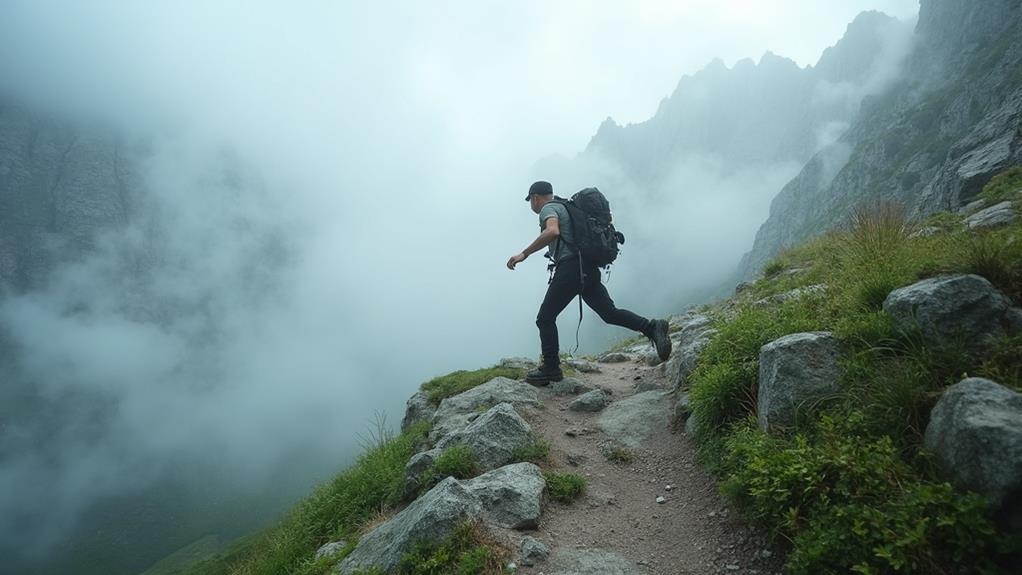
When preparing for the unpredictable challenges of extreme weather hiking, incorporating balance and agility drills into your training regimen is vital. Balance enhancement can be achieved through targeted exercises such as single-leg stands and stability ball workouts, which greatly improve proprioception and stability on uneven terrains. These drills reduce the risk of falls, ensuring safety during adverse conditions. Additionally, agility improvement is essential for maneuvering rapidly changing surfaces. Exercises like ladder drills and cone sprints develop foot speed and coordination.
| Balance Drills | Agility Drills |
|---|---|
| Single-leg stands | Ladder exercises |
| Stability ball workouts | Cone sprints |
| Yoga or Pilates | Lateral bounds |
| Dynamic side shuffles | Side shuffles |
| Plyometric exercises | Box jumps |
Dynamic movements such as lateral bounds or side shuffles are key to increasing lateral stability and quick directional changes, especially important on slippery or unstable ground. Regular practice of yoga or Pilates bolsters core strength and flexibility, foundational elements for maintaining balance during challenging hikes. Engaging in plyometric exercises like box jumps and jump lunges builds explosive strength, enhancing agility and allowing hikers to swiftly adapt to sudden terrain or weather changes. These drills form a holistic approach to preparing for extreme weather hiking.
Hydration and Nutrition Strategies
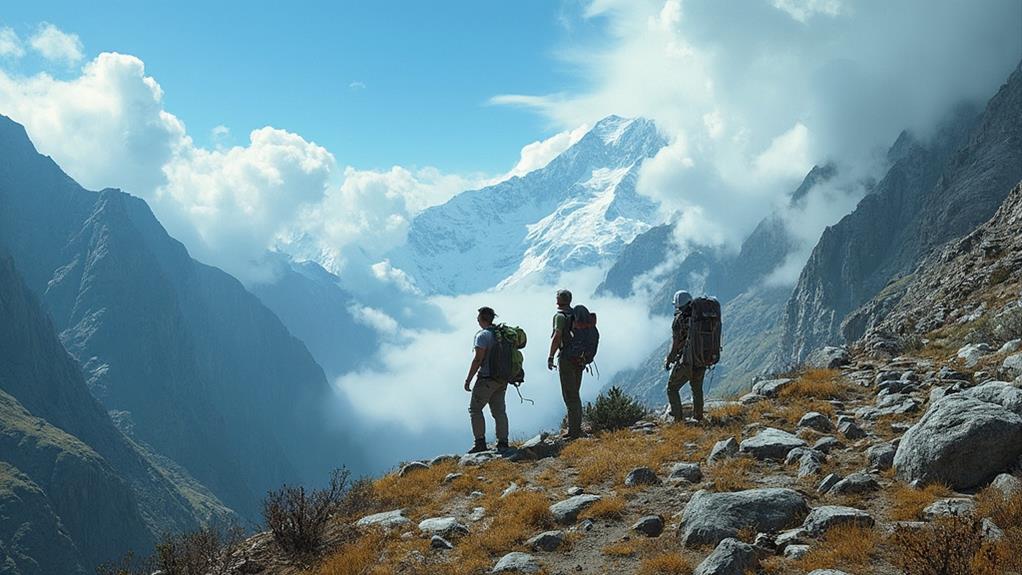
Successfully traversing the rigors of extreme weather hiking demands meticulous attention to hydration and nutrition strategies. Advanced hikers understand that hydration techniques are essential in maintaining performance and safety. The baseline recommendation is to drink at least half a liter of water per hour, with increased intake under hot conditions to stave off dehydration.
Equally important is replenishing electrolytes, like sodium and potassium, through foods or sports drinks to avert muscle cramps and maintain peak bodily functions.
Nutrition timing is another significant element. Consuming high-energy, easily digestible snacks every 30 to 60 minutes is crucial to sustaining energy levels and warding off fatigue. Energy bars and dried fruits serve as practical options in this strategy.
Additionally, in cold environments, the body's demand for energy rises considerably. Consuming warm fluids and calorie-dense foods becomes essential to maintain core temperature and prevent hypothermia.
Here are three essential strategies:
- Hydration Techniques: Drink consistently and use electrolyte-rich beverages.
- Nutrition Timing: Schedule regular snack intervals to sustain energy.
- Balanced Meals: Opt for meals with complex carbs, proteins, and healthy fats for prolonged endurance.
Cross-Training Benefits
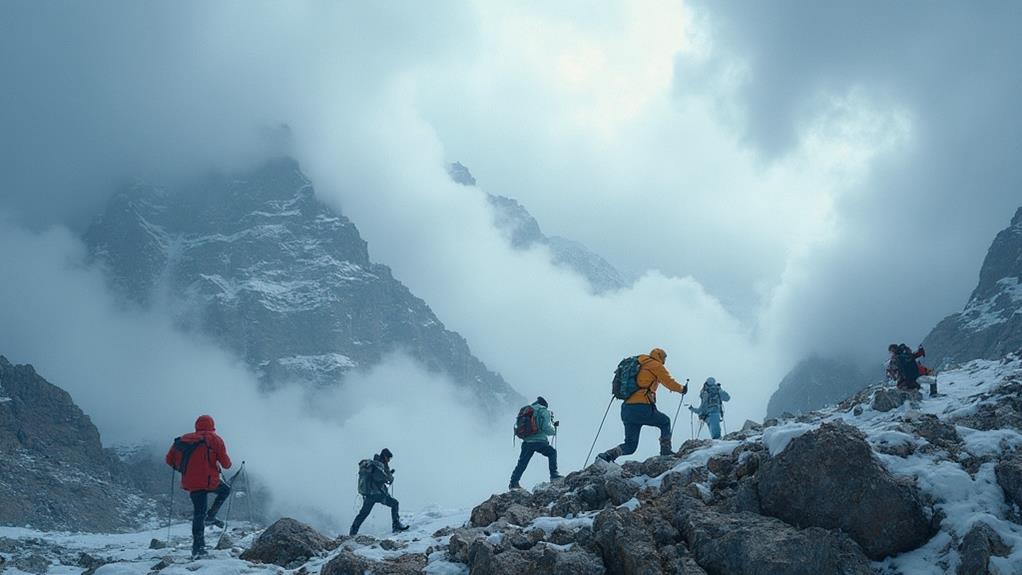
Starting on the journey of extreme weather hiking requires more than just passion; it demands a robust and adaptable fitness foundation, and cross-training is the key to achieving this. By enhancing muscle stabilization and strength, cross-training lays the groundwork for improved balance, essential for guiding through treacherous terrains under unpredictable conditions.
Incorporating exercise variety, such as cycling and swimming, targets different muscle groups, fostering a well-rounded fitness regime. This variety not only builds physical resilience but also aids in muscle recovery, a fundamental component for maintaining peak performance.
For advanced hikers, consistent cross-training enhances endurance, preparing the body for the rigorous demands of hiking in challenging environments. High-Intensity Interval Training (HIIT) offers short, impactful workouts that enhance cardiovascular fitness, an absolute necessity when facing prolonged exertion in harsh weather.
Meanwhile, integrating low-intensity steady-state (LISS) cardio, like trail running, sustains endurance levels, allowing hikers to tackle long-distance treks with confidence.
Thus, cross-training serves as an essential tool, equipping hikers with the strength and stamina needed for extreme weather adventures. By diversifying training routines, hikers not only improve their performance but also boost their safety, ensuring that each step taken is both powerful and secure.
Injury Prevention Techniques
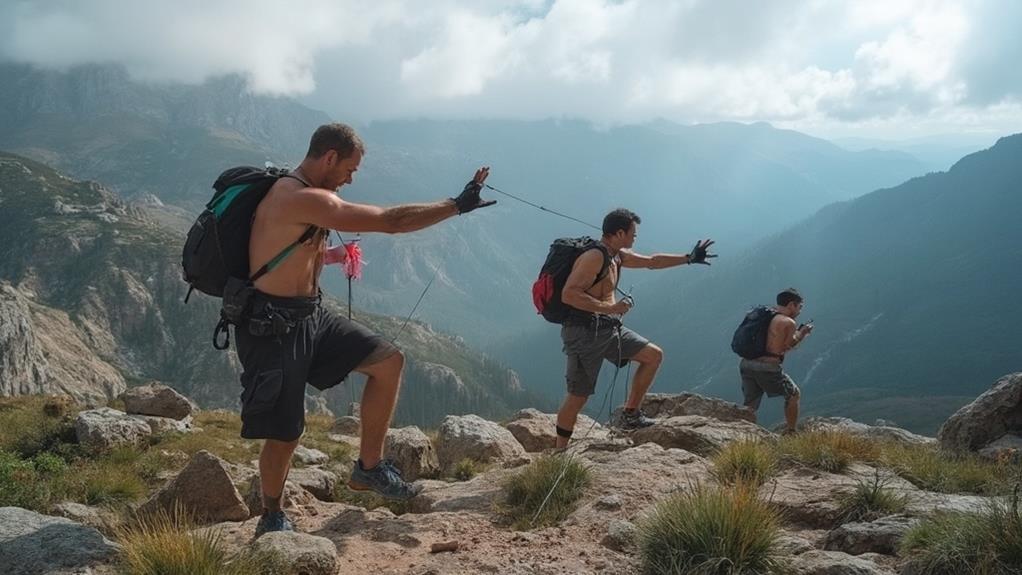
Preparing for the unpredictable challenges of extreme weather hiking begins with a robust approach to injury prevention, centered on core stability and joint flexibility.
By integrating targeted strength training exercises, hikers can enhance stability, particularly in the lower body and core, which is essential for maneuvering rugged, uneven terrains.
Additionally, optimizing warm-up routines with dynamic stretching prepares muscles and joints for the rigors ahead, reducing the risk of strains and sprains as conditions shift.
Strengthen Core Stability
A strong core is an essential asset for hikers venturing into extreme weather conditions, as it forms the foundation for both stability and injury prevention. Core stability enhances balance and coordination, vital for maneuvering the uneven and challenging terrains typical of such environments.
To fortify your core, consider incorporating core engagement techniques and dynamic core workouts into your training regimen. These exercises not only bolster trunk stability but also improve posture during prolonged hikes.
Engaging in a structured core strengthening routine can greatly mitigate the risk of injuries. The following are key exercises to include:
- Planks and Side Planks: These exercises target your abdominal and oblique muscles, enhancing your ability to maintain stability on rugged terrain.
- Stability Ball Workouts: Using a stability ball adds an element of balance to your routine, further engaging your core muscles and promoting overall stability.
- Twisting Lunges and Rotational Exercises: These dynamic movements build functional strength, preparing your body for the varied demands of extreme hiking.
Research consistently shows that a robust core reduces strain on lower back muscles, preventing common hiking injuries like lower back pain.
Regular practice of these techniques not only aids in injury prevention but also optimizes hiking performance, allowing for efficient energy use during arduous treks.
Enhance Joint Flexibility
While a strong core lays the groundwork for stability in challenging environments, joint flexibility plays an equally pivotal role in preventing injuries during extreme weather hikes. Advanced hikers understand that incorporating dynamic mobility exercises, such as dynamic stretching, is crucial before setting foot on uneven terrain.
These exercises effectively prepare the body for the physical demands of rugged trails by loosening the joints and enhancing flexibility.
Yoga is another powerful tool in a hiker's arsenal. Regular practice can notably improve joint mobility and flexibility, especially in critical areas like the hips, knees, and ankles. By weaving yoga into your joint health routines, you enhance your ability to navigate the unpredictable twists and turns of mountainous paths.
Targeted exercises such as hip rolls and ankle circles can directly increase the range of motion, supporting overall joint health.
Equally important is staying hydrated, as dehydration can lead to joint stiffness and heighten injury risks.
Post-hike, employing foam rollers and massage techniques can relieve joint tension, promoting recovery and maintaining flexibility for future adventures.
Implementing these strategies guarantees that your joints remain resilient, allowing you to face extreme weather hikes with confidence.
Optimize Warm-Up Routines
Before starting on a hike in extreme weather conditions, ensuring a well-structured warm-up routine is essential to injury prevention. A meticulous routine should last 10-15 minutes, focusing on dynamic stretches that boost blood flow and prepare muscles for the challenging terrain ahead. The significance of this preparation cannot be overstated, especially when faced with unpredictable climates and rugged paths.
To optimize your warm-up, consider these key components:
- Dynamic Stretches: Engage in leg swings and walking lunges. These activities simulate hiking movements, activating crucial muscle groups and enhancing joint mobility. This approach not only readies your body for the hike but also reduces the likelihood of strains or sprains.
- Hiking Simulations: Incorporate exercises that mimic trail conditions. Movements like hip circles and ankle rolls specifically target the hips, knees, and ankles, important for maintaining stability on uneven surfaces.
- Gradual Cardio Elevation: Initiate your routine with brisk walking or light jogging. This increases your heart rate, facilitates oxygen delivery to muscles, and primes your body for the exertion of a high-intensity hike.
Always heed your body's signals during warm-ups. Address any discomfort by adapting your routine, ensuring a safe and enjoyable hiking experience.
Post-Hike Recovery Practices

Engaging in post-hike recovery practices is vital for any hiker looking to maintain peak performance and minimize the risk of injury. After an intense trek through challenging terrains, your muscles demand attention.
Start your recovery journey with foam rolling, which is highly effective in relieving muscle tightness and enhancing blood flow. By rolling over sore spots or using a tennis ball, you can target specific areas, ensuring a thorough recovery.
Coupled with this, ice therapy can be a game-changer, especially after enduring extreme weather conditions. Applying ice to inflamed areas for 15-20 minutes helps reduce swelling and manage pain, allowing your body to heal more efficiently.
Beyond these targeted approaches, a detailed post-hike routine includes stretching major muscle groups such as calves, quads, and hamstrings to prevent stiffness and enhance flexibility.
Hydration plays a significant role—aim to drink 16-24 ounces of water for every hour hiked to replenish lost fluids.
Gear Selection and Packing
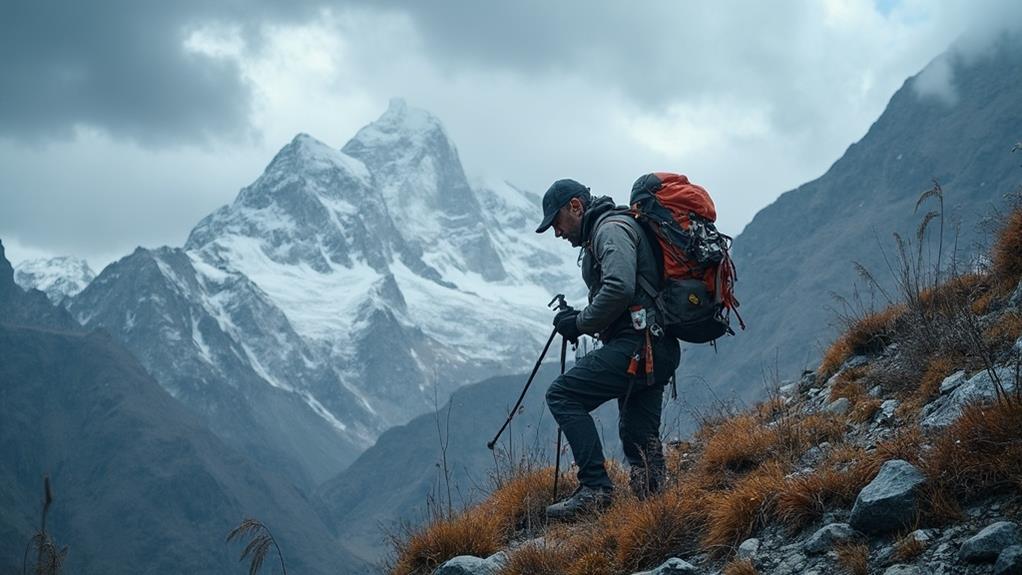
After ensuring your body is well-recovered from the rigors of a demanding hike, attention must turn to gear selection and packing, vital elements for successfully maneuvering extreme weather conditions.
The foundation of your gear lies in moisture-wicking base layers, which are pivotal for regulating body temperature by keeping sweat away from your skin. Insulated and waterproof outer layers, complete with adjustable hoods and cuffs, shield you from rain and wind, while fleece or down mid-layers offer warmth without added bulk. These layers allow seamless adaptation to the unpredictable shifts in temperature that one encounters in extreme environments.
Packing efficiency is essential, ensuring that your gear not only serves its purpose but also fits neatly within a well-organized backpack. Choose lightweight yet durable equipment, such as a high-quality tent and a sleeping bag rated for severe conditions, to safeguard your comfort during overnight stays.
To maintain gear longevity, consider these gear maintenance tips:
- Regularly inspect your gear for wear and tear, addressing any issues promptly.
- Clean and dry your equipment after each use to prevent mildew and damage.
- Store gear in a cool, dry place to extend its lifespan.
Incorporating these practices optimizes your hiking experience, providing peace of mind and readiness for any adventure.
Community Support and Resources

Exploring the world of extreme weather hiking becomes considerably more rewarding when bolstered by a robust network of community support and resources. Engaging with local connections such as hiking clubs offers a treasure trove of advice and shared experiences. These groups provide motivation and foster an atmosphere of camaraderie essential for advanced hikers tackling the challenges of harsh climates. Similarly, online resources, including social media platforms and hiking forums, serve as a nexus for enthusiasts to exchange tips and strategies for maneuvering severe conditions.
| Resource Type | Benefits |
|---|---|
| Local Hiking Clubs | Shared experiences and motivation |
| Online Communities | Tips and strategies for harsh climates |
| Group Training | Hands-on experience and guidance |
| Expert Blogs/Podcasts | Gear insights and safety practices |
Participating in group training sessions or workshops provides hands-on experience, often led by seasoned hikers and trainers. These sessions are invaluable for honing skills and acquiring knowledge critical for extreme weather preparedness. Expert blogs and podcasts further enrich one's understanding with gear recommendations and safety practices tailored for challenging environments. Community events and organized hikes offer not only networking opportunities but also exchanges about local weather patterns and effective coping strategies. Together, these resources create a thorough support system for those daring to venture into nature's most formidable terrains.
Frequently Asked Questions
Can You Train to Prevent Altitude Sickness?
Yes, preventing altitude sickness through training is feasible. Effective acclimatization techniques, such as gradual ascent and moderate altitude exposure, combined with hydration strategies, enhance physiological adaptation, reduce symptoms, and improve oxygen utilization, ensuring a safer high-altitude experience.
What Makes an Advanced Hiker?
An advanced hiker excels through meticulous navigation skills and rigorous endurance training, enabling them to confidently navigate complex terrains. Their expertise encompasses strategic gear selection, environmental risk assessment, and survival proficiency, ensuring preparedness for any outdoor challenge.
How to Train for High Altitude Trekking?
Training for high altitude trekking necessitates altitude adaptation and mastering breathing techniques. Prioritize acclimatization at elevations above 8,000 feet, enhance aerobic capacity with steady-state cardio, and practice diaphragmatic breathing to optimize oxygen utilization and mitigate fatigue.
How to Train for Heavy Load Hiking?
To effectively prepare for heavy load hiking, focus on load management by gradually increasing pack weight. Combine this with endurance building through long-distance hikes, strength training exercises, and cross-training activities to enhance overall stability and fitness.
Conclusion
In summary, mastering hiking in extreme weather conditions requires a multifaceted approach that emphasizes physical resilience, strategic training, and meticulous preparation. Advanced hikers must engage in rigorous strength and cardiovascular conditioning, incorporate simulated weather scenarios, and focus on balance and agility to enhance stability. Prioritizing injury prevention and post-hike recovery is essential, as is selecting appropriate gear. Leveraging community support and resources further enriches the experience, ensuring safety and success in challenging environments.